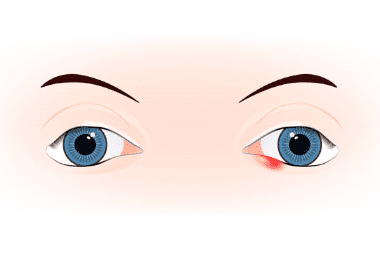Ophthalmology >>>> Barley - how to speed up your recovery
Barley - how to speed up your recovery.

Barley belongs to the category of bacterial diseases of the eyelids. This disease proceeds in an acute purulent form, affecting the hair follicle of the eyelashes or the sebaceous gland. Sometimes in the medical literature, this disease is called "acute meibomitis " after the name of the meibomian glands involved in the inflammatory process.
As a rule, barley occurs on one eyelid, but it can also have multiple scatter and affect the eyelids of both eyes. There are two options for the course of the disease barley:
if the hair follicle or meibomian glands of the cartilage are affected , then internal barley develops ;
if Zeiss sebaceous glands or Mull's sweat glands are affected, external barley develops.
Barley occurs as an independent disease, but very often it can be the result of other disorders in the body or a general decrease in the resistance of the immune system to infections. Statistical studies show that staphylococcus bacteria provoke the highest percentage of barley development. But when prescribing treatment, more reliable laboratory tests are done and the strain of the pathogenic bacteria that caused this disease is specified.

Barley signs:
- At the very beginning of the development of the disease, itching occurs in the region of the edge of the eyelid, which gradually turns into pain when pressed.
- A lump of limited size forms at the edge of the eyelid.
- The eyelid conjunctiva and adjacent eyelid skin swell.
- Regional lymph nodes may enlarge.
- After two to three days, an abscess appears, around which swelling and tissue hyperemia (redness) persists. An abscess can also be seen by twisting the eyelid, on its inner surface, it will shine through the conjunctiva.
- After a few more days (4-5), the abscess matures and opens itself, after which the healing process begins.
What not to do when barley occurs:
- Comb so that the infection does not spread throughout the centuries
- Squeeze out, as this may lead to complications such as phlegmon, thrombophlebitis of the orbital veins, purulent sinusitis, meningitis and even death
- Make compresses and lotions (soften tissues and provoke an expansion of the focus of a purulent infection)
- Use cosmetics during the period of inflammation and healing of barley
- Use other people's objects (towels, napkins, handkerchiefs) to wipe your face, which contributes to the spread of infection
Treatment for barley depends on the severity of the disease. A mild form, when the abscess breaks through on its own, makes it possible to cope with barley on its own, does not require any additional action. Is that warming up - UHF, blue light; lubrication with 70% - alcohol solutions, which will accelerate the process of maturation of the abscess.
You can use antibiotic ointment and / or antibiotic drops. Drops and ointments should be designed specifically for the eyes. The ointment is applied to the side of the eyelid (outer or inner) from which the abscess is visible. Drops can be used as an addition to the ointment, while pulling the eyelid and dripping into the formed pouch. When the abscess breaks through, you can bury it for its fastest healing, but not for long (according to the instructions for the drops).
If the abscess does not break out within the specified period of time, then the help of a doctor is needed. The doctor will inject into the abscess itself or open the abscess to accelerate the outflow of pus. With the complication of the course of processes, antibiotic therapy, fortifying drugs (vitamins, especially of group B, immunostimulants) are prescribed.
Complications of the course of barley disease lead to abscess or necrosis of the tarsal connective tissue.
By the way, about "spitting in the eye" - this beloved by some people remedy for the treatment of barley. Human saliva contains conditionally pathogenic microorganisms , which, when it gets on the mucous membrane of the eyes, eyelids, and so on, will add more troubles to the sick person in the form of other infectious eye diseases (viral, bacterial or fungal). Think about it!

Read

Read



























